Feature Interview with Lorne Rubenstein
March 2000
Lorne Rubenstein is the long time columnist for Toronto’s Globe and Mail and has contributed articles to virtually every major golf publication, including GOLF Magazine, Golf Digest, and Golf Monthly. He is a past winner of Golf Writer’s Association of America award for the best feature article. Lorne has penned many books as well including The Natural Golf Swing with George Knudson and one of our favourites, Links. Lorne’s low handicap travels extremely well but he always calls Toronto home.
1. What three attributes must a course possess to draw you back again and again?
For one thing, it-well, the club anyway, if not the course– shouldn’t have a few things. I dislike: valet parking, halfway houses; yardage markers everywhere; global positioning systems, mandatory riding. I could go on and on here.
But I like ¦
a) A feeling of remoteness and isolation, what I call an ‘end of the world feeling.’
b) Holes that look and play differently the one from the other.

The extraordinary view behind the ninth at Brancaster
c) Extraordinary views and vistas that never fail to interest no matter how often one has been there-for instance, the view to the sea over the brow of the hill at New South Wales (La Perouse), the endless flowering bushes at Bali Handara, the tide rolling in at Royal West Norfolk (Brancaster), the view to the sand dunes all down the shoreline from the 11th at Ballybunion, the view to downtown Vancouver while one plays the early holes at Capilano.
2. You once wrote an article saying how much you enjoyed playing Royal Sydney. What do you find so appealing about it?
Who knows? It’s always hard to put one’s finger on what appeals. It’s like a fine meal or seeing a movie that gets to you. There’s an overall feeling of unity, that the thing made sense and worked its way under your skin.
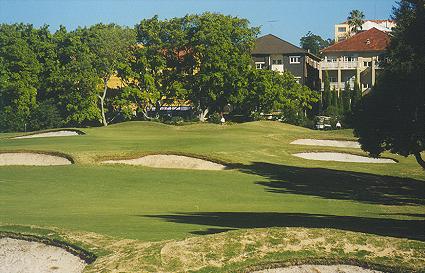
Royal Sydney – part of the city life.
But I have to say something, so here goes. The first thing that pops into my mind is a picture, so that must be it. I like the frame of the course as much as what’s in the frame. The course, though it’s private, seemed part of the city life. There was a sense throughout of simply having a pleasant walk in the city and hitting golf shots along the way. I also liked the opening, short par-four, the sort of hole that says to me this course is meant to provide an enjoyable experience; at the same time one simply couldn’t whale away because of the bunker in front of the green. I also enjoyed the way the clubhouse stands sentinel over the course. This added to the ambiance, which is part of the golf experience to me.
3. Do you think Stanley Thompson receives the recognition he deserves as an architect?
Thompson is starting to become recognized and even celebrated in Canada, where he lived and did most of his work. There’s a society that honours his work, and a biography is in the works. However, he is rarely mentioned in the same breath outside Canada with the classic designers with whom he deserves to be grouped-Donald Ross, A.W. Tillinghast, Seth Raynor etc. Too many people don’t realize that he was, along with Ross and Robert Trent Jones Sr., a founding member of the American Society of Golf Course Architects, or that he hired Jones before forming a partnership with him for a few years. Had Thompson worked more outside Canada he would be better-known. At the same time I’m certainly glad he devoted so much time to Canada. I grew up on a Thompson course called Uplands, just north of Toronto’s city limits. For a course that barely made it to 6,000 yards and that comprised only 90 acres it was a work of genius. By my reckoning there were 16 fine holes in that limited space; one could be rewarded simply by studying Thompson’s green sites there-plateau greens, sunken greens, greens falling away to hillsides. Brilliant stuff.
4. If time or expense weren’t considerations, which five courses would you most like to see for the first time?
- Machrihanish
- Durban
- Sand Hills
- Prairie Dunes
- Falsterbo
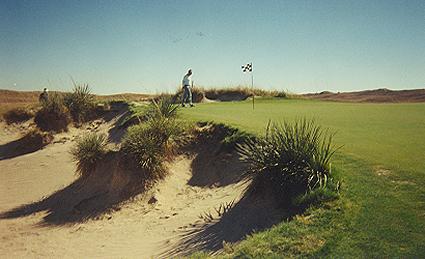
Don’t be short on the 17th at Sand Hills.
5. Tell us about the evolution of Redtail as a club. Also, what single aspect do you most admire in Steel’s work?
Redtail began as an idea in the minds of a couple of London, Ontario men, Chris Goodwin and John Drake. They had made some money in an investment and decided to go ahead and build their own club; Chris and John were and still are members of the London Hunt and Country Club, but now had the means to do their own course. However, they didn’t see the point of spending millions and millions. This was to be a golf course and a golf course only, and moreover, it would not have members as the word is traditionally defined. In any case, Chris and John were told by their friend Brendan Lynch, an R&A member, of the work that Donald Steel was doing, and that they should meet him. Donald came over in due course and saw the Redtail property, which is in deep rural southwestern Ontario, some two hours by car southwest of Toronto and a couple of hours east of Detroit. The land was nicely rolling, and a ravine was its essential feature; there were also enough trees to add variety on this piece of land.
The owners’ brief to Steel, was, well, brief. They asked him to design a course that would take full advantage of the landscape, and that could play firm and fast. Steel impressed Chris and John with his knowledge of classic links courses, and as an aside, I should mention that his book of the same title is the best of its kind-the writing is pure and simple. And that is Redtail-pure and simple, at least in presentation. As I recall there are only 29 bunkers on the entire course, each one of which comes into play. There isn’t an element that seems added or unnecessary. Redtail is as understated a course as one could hope to find, yet it is both a visual treat and a demanding layout. Golfers who are fortunate enough to participate in the club’s Round Table-a group of avid golfers drawn from around the world-rate Redtail as a quintessential golfing experience. I certainly do, and have done so from the moment I set eyes on it.
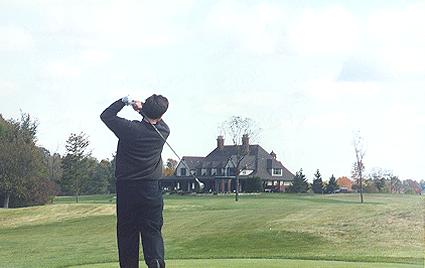
The home hole at Redtail – little land was moved.
As for Donald Steel’s work, I admire its complete lack of artifice. Donald knows golf through and through; he was a quality player who competed in the 1970 Open Championship at the Old Course, is a member of Royal Dornoch and the R&A, and wrote incisively about the game for many years, for the Telegraph in the U.K. and for other publications. His essays on course architecture should be required reading. Donald knows the value of a hole quietly presented and elegantly shaped-a hole that introduces confusion into a player’s mind because there are options at hand. He believes in the ground game as well as the air game, and designs his green complexes accordingly-it is usually possible to run the ball into a Donald Steel green. To play a Steel course, in my experience, is to feel his touch lightly; but it is a sure touch that brings out the golf course in a piece of land.
6. What five holes (from different courses) do you wish you could say you designed?
First, I’ll say that I’ve never looked at holes in this way. I’m no course architect. I’m a golf writer and I like a hell of a lot of different things about golf courses and golf holes and I also dislike a lot of things. I’ve never cared much for sitting around after a round of golf and wildly criticizing holes. Hell, I’m usually just glad to be out on the course alone or with some pals or new friends. I can’t figure out why so many people fancy themselves as architects; do they think architects would have something intelligent to say about their work? Usually I fade away during such conversations or simply excuse myself and say I’m going out to play a few holes by myself or hit some balls; or I might slink off to a corner of the clubhouse and read something. People who have no business doing so take course architecture far too seriously. And while I’m on that subject-although I’m on Golf Magazine’s panel-I can’t quite understand the mania for ranking courses. Too much of the whole thing is politics, or depends on the willingness of panelists to travel. Maybe I feel this way because I’m from Canada, and most panelists, especially American ones, think Canada is three days travel away. One time a panelist for a magazine was astounded to find out that he could get from New York to a course near Toronto, play it and come home the same day. American panelists who grovel to play the courses in that supposed hotbed of classical golf-the New York area, that is-mostly visit Canadian courses only when they’re all but forced to by somebody who points out their geographical ignorance. And then they think they need to arrive with snowshoes in June. And hell, I love New York. It gets worse, too. Talk to a panelist in Florida or California and you can be sure the guy’s never even considered coming to play some of the Canadian courses. If these people are legitimate panelists shouldn’t they be open-minded enough to get to more courses? But their eyes glaze over when I talk about Canadian courses. They think there couldn’t possibly be anything worth playing in Canada. I mean, hockey’s the national sport, right? And Canada is cold 10 months of the year, right? They’re shocked when I point out on a map-not that they’ve ever looked at one-that a lot of areas in Canada where golf is popular are actually south of the northern parts of the U.S.
Anyway, now that I’ve gotten that off my heaving chest, here’s a list of holes I really like. I don’t know if I wish that I’d designed them, but I’d love to play them as often as possible.
- 8th, Pebble Beach
- 5th, Pine Valley
- 6th, Ballybunion
- 4th, Royal County Down
- 8th, (formerly 17th at Uplands in Toronto)
7. Please put together your ‘All-Canada’ eclectic 18, being loyal to the hole number and taking no more than two holes from one course.
This is an impossible task because I’ll leave out so many great holes that don’t fall in the right place. It’s also something I’ve never thought about, and besides, I have hardly played all the fine courses in Canada. It’s a gigantic country. My education is far from complete. Anyway, forced to do so here, I submit.
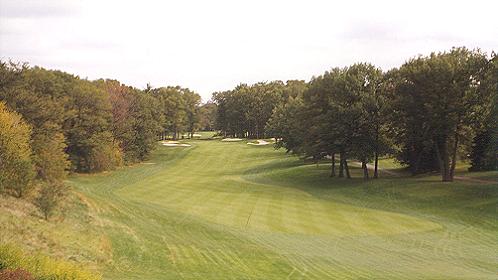
‘The finest opening hole in Canada.’
- St. George’s, Toronto, 378 yards, par-4 (Stanley Thompson)
- Mad River, Creemore, Ontario, 455 yards, par-4 (Bob Cupp)
- Cataraqui, Kingston, Ontario, 440 yards, par-4 (Stanley Thompson)
- Toronto Golf Club, 190 yards, par-3 (Harry Colt)
- Weston, Toronto, 424 yards, par-4 (Willie Park Jr.)
- Devil’s Pulpit, Caledon, Ontario, 420 yards, par-4 (Michael Hurdzan)
- Highland Links, Cape Breton Island, 570 yards, par-5 (Stanley Thompson)
- Uplands, Toronto, 225 yards, par-3 (Stanley Thompson)
- Mississaugua, Toronto, 390 yards, par-4 (George Cumming)
- Deerhurst Highlands, Huntsville, Ontario, 464 yards, par-4 (Bob Cupp, Tom McBroom)
- National Golf Club of Canada, Woodbridge, Ontario, 400 yards, par-4 (George and Tom Fazio)
- St. George’s, Toronto, 380 yards, par-4 (Stanley Thompson)
- Redtail, St. Thomas, Ontario, 480 yards, par-5 (Donald Steel)
- Glen Abbey, Oakville, Ontario, 425 yards, par-4 (Jack Nicklaus)
- Highland Links, Cape Breton Island, 540 yards, par-5 (Stanley Thompson)
- Beacon Hall, Aurora, Ontario, 226 yards, par-3 (Bob Cupp)
- National Golf Club of Canada, Woodbridge, Ontario, 425 yards, par-4 (George and Tom Fazio)
- Hamilton Golf and Country Club, Hamilton, Ontario, (south nine), 429 yards (Harry Colt)

The demanding approach to the 17th at the National.
8. For how many modern course designers do you go out of your way to see their work?
I would go out of my way to see the work of a half-dozen to ten designers-Donald Steel, Tom Doak, Steve Smyers, Ben Crenshaw and Bill Coore, Tom Fazio, Doug Carrick, Rees Jones, Robert Trent Jones Jr., Pete Dye. (You see, I just like to see what people are doing). Some professional golfers are also doing very good work-Crenshaw, Tom Weiskopf and Greg Norman in particular. Crenshaw’s Talking Stick near Scottsdale is superb in my opinion because is allows a ton of room to drive the ball and still insists upon a player finding a favorable spot on the fairway to get the best angle into the greens; and I thought the bunkering was inspired-Riviera-like. Weiskopf’s (and Jay Morrish’s) Double Eagle in Columbus is outstanding, and I think Norman (and Pete Dye’s) Medalist Golf Club in Hobe Sound, Florida is an illuminating blend of what he likes about Royal Melbourne, the Old Course and Augusta National. I have also enjoyed some of Jack Nicklaus’s work, and recenty toured his new course The Bear’s Club; I think it will be recognized as one of his best. I am also eager to see the work that Nick Price will do on a new course he will design near the Medalist, where he will work with Tom Fazio. Nick has a fine feeling for the nuances of golf holes from playing around the world, so it will be interesting to follow his efforts there.
9. What course is a personal favourite with which the readers may not be familiar? What do you like about it so much?
I like the Cataraqui Golf and Country Club in Kingston, Ontario, which Stanley Thompson designed. Cataraqui in my mind’s eye exists as a unified picture from the first tee to the last green. It opens with a short par-four in a slight bowl, but the green is slightly raised. Then the green at the second, a lengthy par-3, sits into the ground. We move onto higher ground for a few holes that play through wooded land, and then eventually move back to lower ground before ascending for the final few holes. There’s a pleasant feeling of meandering over the land, and finding arresting holes everywhere. I never play Cataraqui without feeling refreshed. And there’s nothing like coming off a course feeling more energized and alert than when one started the round.
I’d like to add without elaboration a few more courses I really like with which readers might not be familiar.
Royal Worlington and Newmarket; Royal North Devon; Saunton; Burnham & Berrow; West Sussex; Jagorawi (Indonesia); Mountain Ridge (West Caldwell, New Jersey); Royal West Norfolk; Southerness; Brantford (Ontario); Osprey Valley (Alton, Ontario).
10. Which five courses provide the most fascinating green complexes?
Oh no, another ‘list’ question. Here goes anyway.
- Pine Valley
- Old Course
- Augusta National
- Royal Worlington and Newmarket
- Medalist (try the pitch shot to the 16th green from the bunker to the right and you’ll know what I mean)
11. How do you think this period in course architecture (1985-1999) will be viewed in fifty years time?
It will be viewed as a time during which there was a wide division between minimalism and extravagance; that is, as a period in which some people believed it was possible to do anything with money and equipment, while others wanted to pull back and go the other way entirely. More than anything, I would call this the age of extravagance, as evidenced in Shadow Creek, Trump International, the Devil’s Pulpit and many other new and super-expensive courses. It’s getting disgusting, really. Soon the only people who are going to be able to play golf are the young Silicon ValleyInternet billionaires. I’m sick of the term ‘high-end’ course. We need ‘low-end’ courses where a golfer can sling a set of clubs over his shoulders and walk and play the course in less than four hours.
12. How do you compare the merits of Jasper Park to those of the original course at Banff Springs?
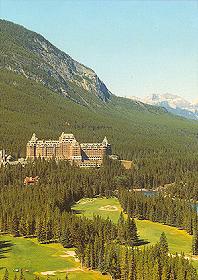
The glories of Banff.
Jasper Park was and is a softer, gentler course where the mountains seem more in the distance and so wrap the course in a sort of filament. Banff is the more difficult, more rugged course, and its original first hole where one drove from a high tee across the Spray River was one of the strongest and most dramatic opening holes in the game. It’s regrettable that the hole was later stuck in the middle of the revised course.
13. What is the most challenging course in Canada for you to play to your handicap index of 3.1? Which course is the most fun?
It’s always difficult for me to play to my handicap at the Brantford Golf and Country Club, perhaps because of its series of long, arduous par-4s. As for the most fun, well, Redtail and Highland Links qualify there for me. Anyway, if I keep writing instruction books I’m going to be one very confused golfer. Still, I like talking about the swing as much as some people like discussing and dissecting golf courses. We need a panel of golf swing rankers; can’t you see it-the top 100 modern swings and the top 100 classical swings.
14. What five courses make the player ‘think’ the most?
Most players don’t think anyway. They stand up and smash the ball, or try to. Why do you think everybody is buying bigger and bigger drivers? Or hitting irons that don’t get them past the hole even if they strike the ball solidly? Of course the problem is that there’s not much to think about when you have to carry a lake or a bunker the size of Minnesota or Saskatchwan. Golf in North America and now in Europe and often in the new courses in the U.K. is nothing but smash and fly-hit it hard and hit it high and hope it lands on grass.
The way I figure it any course that would make a player think must offer him options for shots, thereby introducing indecision into the mind. Therefore the course must have a variety of holes, including doglegs that move both ways, a healthy supply of different green sites, and ground that will accept a running shot.
So here are some courses that make a player think, and it’s no coincidence that they’re also fun to play. I could add other courses also-Littlestone near Rye in England is a gas because running the ball is always possible. Kingston Heath in Melbourne is a course I could play all day and all week and all month because of the shot possibilities. Anyway, here you are.
- Pine Valley
- Old Course
- Royal Melbourne
- Augusta National
- Ballybunion
15. What book(s) are you working on at the moment and when are they due out? Please tell us about them.
I’ve been helping David Leadbetter write The Fundamentals of Hogan, an analysis of Ben Hogan’s swing while also examining what we have learned about the swing since Hogan played his remarkable brand of golf. The book should be out in early spring. I expect also to be living near a famous old links course this summer and to write a book based on my experiences there. More on that another time.
16. You are an admirer of Royal Worlington and Newmarket. How would you compare it to other inland courses in the British Isles?
It’s unique as far as I know. For one thing it’s only nine holes, and as far as I know only two-balls are allowed. The piece of ground is modest in the extreme, but the golf can be demanding in the extreme. You have to play smart-the lack of highly visible features only hide the significant features that make the golf as compelling as it is. This is stripped-down golf, where a fence and a single long bunker can compress a fairway so that it seems narrow, as at the first hole. Then there’s the quirkiness of the course-an aspect of golf courses I enjoy whenever I find it. It doesn’t bother me at all if one has to hit a shot across a corner of the fourth green to reach the fifth green, or, at a rather more famous course-Cypress Point-if there are consecutive par-3s, as at the 15th and 16th. So lies the land. So go the shots. I could go round and round Royal Worlington, or Mildenhall as the members call it for the village in which it’s located. I’ve played many British inland courses-Walton Heath, Coombe Hill, the Old at Sunningdale, and others. I enjoy them all, but Royal Worlington is as charming as a golf course can be. If it’s anachronistic, well, I’d like to time travel there.
17. Few if any cities have more first-rate classic AND modern designs than Toronto. How do you account for it?
Having lived there all my life, I’ve never thought much about this question. The number and variety of courses is simply something I grew up with. But I do recall writing a rebuttal article to a piece in Golf Digest that stated Columbus, Ohio was a place to study course architecture because of the architects represented there. I argued for Toronto, and anybody who has visited the city for golf would agree. (I’m sounding like a chamber of commerce fellow here, aren’t I?) Still, the point is right on the money: Toronto is an advanced school for the study of course design, classic and modern.
The city is built on ravines and valleys. It’s a lakefront city cut through with ravines that are old river beds, and so there are sometimes dramatic changes in elevation that one sees incorporated into courses such as Weston, Toronto Golf Club, Scarboro and Mississaugua. There’s an old nine-holer called the Toronto Hunt Club that sits on the edge of cliffs overlooking Lake Ontario; it was near this lake that the Toronto Golf Club was build more than a century ago. Many Scots settled in Toronto, and they brought their golf with them, and quite naturally got involved in building courses. As the city grew there was still room for courses, and interesting landforms as well. To the north of the city runs a vast moraine, and associated with this one finds such fine courses as Summit, Uplands, Thornhill, The Ladies Golf Club of Toronto, Maple Downs and others.
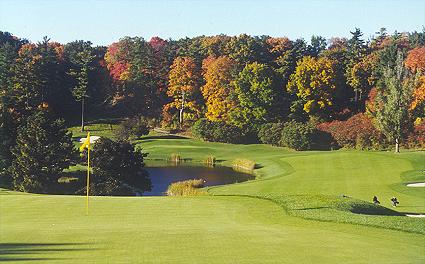
Toronto is blessed with superb topography.
And naturally, because Toronto is Canada’s most-populated city, there is simply that much more demand for courses. I might point out that courses have long been part and parcel of city life, although this is changing to some degree. Stanley Thompson build a short course in the centre of the city in parkland, for instance. And right now another short course is being built on the old rail lands downtown, directly across the street from the offices of the newspaper for which I write a golf column, The Globe and Mail. Meanwhile, one can still take a bus to city courses. That’s a good thing, and I hope this remains possible for years and years.
18. Who are your favourite authors (past and present) on the subject of golf course architecture?
I list these in no particular order. I would happily settle down in front of a roaring fire at some fine course with a glass of Laphroaig and any of the works from these writers; not that all of these were writers; of course most of them are architects.
- Alister Mackenzie
- Stanley Thompson (he wrote an excellent monograph on the subject)
- Sir Guy Campbell
- Bernard Darwin
- Peter Thomson (he is probably the sharpest observer of the contemporary design scene; read anything of his you can find).
- Brad Klein
- Tom Doak
- Geoff Shackelford
- George Thomas
- Donald Steel, as mentioned earlier
I will also be interested to read what Ben Crenshaw has to say on the subject in the book he’s now writing. I expect first-rate commentary. He has certainly read widely on architecture and is a serious student of the subject. He’s unique in this respect. Most golfers designing courses haven’t read anything on course architecture other than the contracts IMG has sent them. They’re not architects. RTJ Jr. calls them ghost-writers. That they are. What a farce. But hey, we’re celebrity-struck. We shouldn’t be surprised at what we get, for we’re the suckers buying the memberships and paying the green fees.
The End








